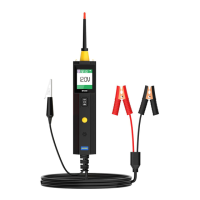Probe the suspected ground wire or contact with the probe tip.
In most cases a short circuit will appear by a fuse or a fusible link
blowing or an electrical protection device tripping (i.e., a circuit
breaker). This is the best place to begin the search.
shorted circuit. Take note of this wire’s identification code or
color.
Follow the wire as far as you can along the wiring harness.
Here is an example for this application.
If you are following a short in the brake light circuit, you may
know that the wire must pass through the wiring harness at the
door sill. Locate the color coded wire in the harness and
expose it.
Probe through the insulation with the probe tip, and depress
the power switch forward to activate and energize the wire.
If the circuit breaker tripped, you have verified the shorted
wire. Cut the wire and energize each end with the probe tip.
The wire end which trips the circuit breaker again is the
shorted circuit and it will lead you to the shorted area.
Follow the wire in the shorted direction and repeat this
process until the short is located.
Remove the blown fuse from the fuse box.
Use the probe tip to activate and energize each of the fuse
contacts. The contact which trips the circuit breaker is the
Checking for
bad ground
contacts
Following &
Locating
short
circuits
With this function, if you are contacting a protected circuit, a
vehicle’s fuse can be blown or tripped if you apply ground to it.
Observe the green LED. Depress the power switch forward
then release. If the green LED went out and the red LED came
on, this is not a true ground.
If the circuit breaker tripped, this circuit is more than likely a
good ground. Keep in mind that high current components such
as starter motors will also trip the circuit breaker.
●
●
●
●
15

